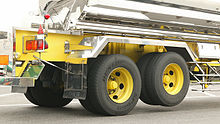Lift axle
In trucks or semi-trailers, a lifting axle is an axle that does not run continuously on the road, but is raised when the vehicle is under low load .
When raised, the wheels do not turn, which has several advantages:
- Reduced tire wear, especially when cornering (when driving straight ahead, however, slightly higher wear in the other tires that are still in contact with the road.)
- Fuel savings through reduced bearing and tire friction
- Reduced tolls for tariffs that are to be paid per axle (e.g. in Italy)
- Significantly reduced turning circle when raised (if the lifting axle cannot be steered )
- slightly lower rolling noise ; this hardly plays a role in practice, also because the lifting axle usually only has single tires
- A (usually non-driven) lifting axle can also be used as a starting aid, e.g. B. on a snow-covered road: By raising the lift axle, the axle pressure of the neighboring drive axle is increased, which is harmless for a short time and at low speed.
It should be noted, however, that the braking effect is less when the lifting axle is raised.
A typical area of application for lift axles are trucks with swap bodies , as two-axle vehicles are limited to a maximum of 18 t in terms of their total weight , while three-axle trucks can weigh 25 t.
The lifting axle is usually lowered automatically when a certain load on the other axle is exceeded. For this purpose, the lifting axle sits on air bags, which are inflated or deflated via three-way brake relay valves in order to lower or raise the axle.
Lift axles are divided into leading and trailing axles . Usually trailing axles are used; i.e., they are arranged downstream of the drive axle.

